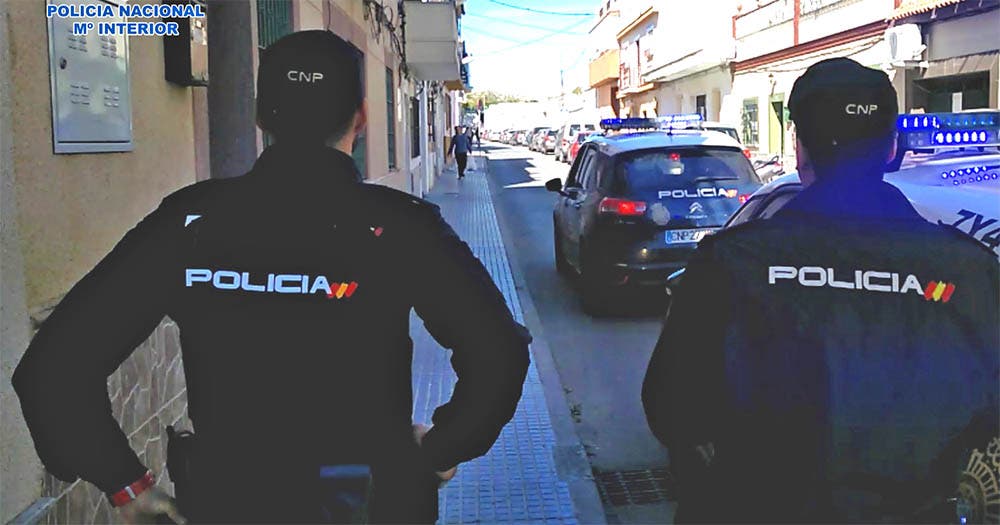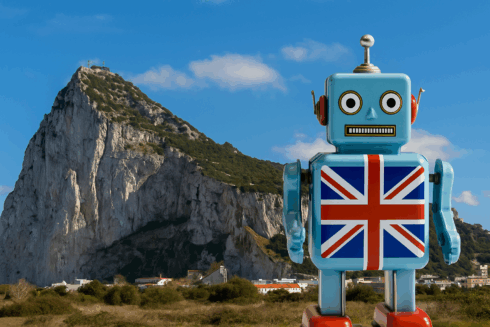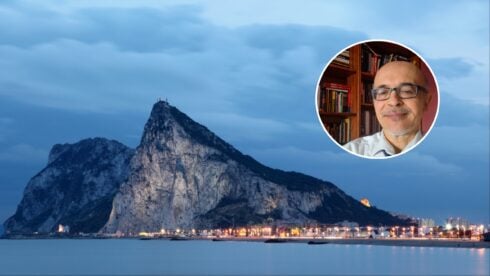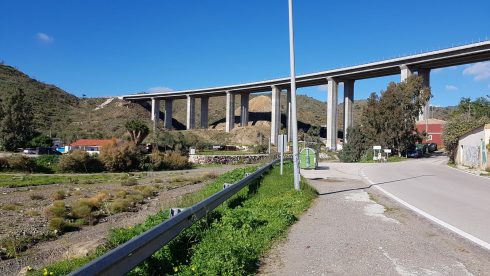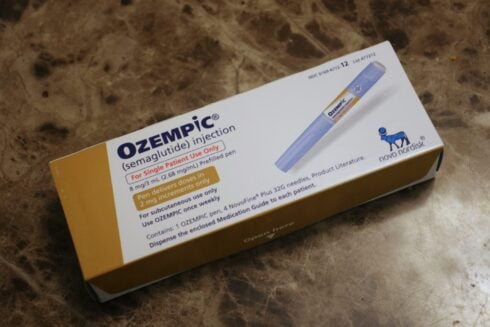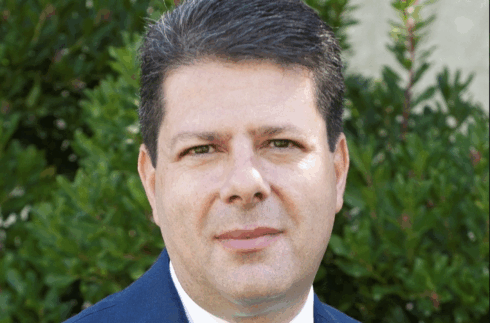Cristo keeps her eyes low as she serves us our drinks. A Fanta Limon and a Coke, both straight out of the freezer, she blasts the cans with hot water to melt the ice that encases them before sliding the drinks over to us.
She’s been here since 2002, she tells me, but she won’t say her real name. She is working in a place that skims the line between La Linea and El Zabal, where the air is thick and the people are sparse – an industrial wilderness on the Spanish-British frontier. She knows better than to answer too many questions.
She swats my probes away with the same ease that she bats away the flies that swarm around her cafe, making no effort to hide her disdain. Instead she exhales: “It’s frying here” and I watch a bead of sweat roll down her cheek.
“Si,” I reply, “this place is on fire.”
Welcome to La Linea, an enclave in southern Spain that got its name – the line- because it is the crossing point from Spain to Gibraltar. Each day 36,000 people move daily across the border from La Linea to Gibraltar, along with 10,000 vehicles, 180 trucks and 40 buses.
The imposing silhouette of the Rock of Gibraltar offers no shade to the residents of this gritty city, but there’s no doubt the shadow of drug crime and violence looms large here.

It’s the proximity to both Gibraltar and Morocco – and the extreme isolation that the industrial town guarantees – that has made La Linea a key base for criminal gangs and drug kingpins. Located roughly eight kilometres south of San Roque, history tells it that when Franco closed the frontier in 1969, it was La Linea that suffered the most.
Workers lost their jobs on the Rock overnight and the town’s population dropped by 35%.
After 16 years of Spanish-imposed isolation, the gates were reopened in 1985 but the damage was done.
Today the area remains in a perpetual state of decay and for the past 40 years or so, drugs have been the economic bedrock of this stifling and sterile nook of southern Spain.
Unemployment rates in 2020 hover around the 33% mark – a fact that has pushed many of its people into assisting the Rock’s smugglers by warehousing contraband tobacco from Gibraltar and drugs from Morocco before it is distributed throughout mainland Spain.
The air is thick with dust and pollution and when I put my hand on the car window and heat ripples through the glass.

We had come here to report on the secret narcoville busted by police earlier this summer in El Zabal. The luxury villas, all built illegally using criminal funds, boast swimming pools, hidden underground tunnels, escape routes, armoured doors and sophisticated surveillance systems. None of them have numbers and all are surrounded by metres high walls, making them only visible from the sky, where they are notable for their perfectly pristine lawns made of artificial grass – not even a gardener is welcomed into this impenetrable fort.
Streets of heat
The streets seem almost to be pulsing red on the humid August afternoon when we arrive. After gleaning little from Cristo in our cafe stop, we park the car on the backstreets between La Linea and El Zabal and open Google Maps, flipping to satellite view in the hopes of finding… something.
Above the hum of the car engine and the buzz of mosquitos, I heard first a scream, then the angry voices of a crowd rising. We get out of the car and see that about a dozen armed men, their faces masked but wearing black uniforms and the badges of the Policia Nacional, had surrounded the area.
The four story block of apartments is filthy – sun bleached and peeling, the scene drained of colour save for the damp, bright laundry draped from a stick outside the barred windows.
We walked down the dusty road, into the furnace heat and I silently pulled out my phone to film what looked to me like a drug raid.
On our way past, one of the officers caught sight of us and was furious; he threatened to take me to the police station for filming, even though we were on a public street.
“How long have you been watching us? Why are you here?” he yelled over and over. “Borrar el video. Delete, delete, delete.”
I was marched into the courtyard of the estate, littered with dirt , trash and empty bottles, where police were reprimanding a man. He was grunting and yelling – resisting arrest – and the crowd surrounding us was swelling. Police clasped their guns a little tighter.
I protested, “I am a journalist,” but the police refused to let me go.

Shay, a colleague with me that day, was sent to the car by officers to retrieve my ID. I made moves to follow him and three officers stepped in front of me, cornering me back into the courtyard. “No,” one said. “You stay.”
Shay returned with my ID – a driver’s licence. Not good enough, apparently.
“This only proves that you drive, not who you are,” a female officer said in Spanish. I was incredulous.
It was clear the police didn’t want anything filmed or photographed, insisting that I permanently delete whatever I had recorded. That does not make good journalism but attempting to argue with them only brought threats and increased hostility.
“We will take you to the police station,” the leader of the pack continued to shout at us.
Later Shay explained my error – I had a flip cover on my phone and each time I was folding it over the officer was becoming more irate.
“He didn’t trust you, that you were hiding something. He didn’t believe you deleted it and he didn’t believe you were who you said,” Shay said later. “He was worried they were identifiable.”
“Even in a hat, mask and glasses?” I asked.
“Si,” Shay replied. “They are obviously nervous.”
And they have a right to be. A city with a population of 63,279, police officials estimate that there are more than 30 gangs here that employ around 3,000 people.
It’s this harsh environment and boom in drug trafficking that first caught the eye of the production company Atar Agreements together with Mediaset.

Producers carried out 81 interviews and shot 336 hours of footage, speaking to agents from different police forces and travelling to Monaco to document how drugs are taken from Africa across the water and into Europe.
The result is a miniseries for Netflix that’s been marketed to viewers as a glimpse at the ‘day-to-day of the conflict in one of the largest enclaves in the country”, that was released at the end of last year and shot to the top of Spain’s Netflix chart.
I know I am lucky to leave La Linea with little more than a telling off – and I am aware this incident is small fry compared to what others have seen and suffered in this city this summer.
For most of the year, the Spanish authorities have been closing in on Jesus Heredia — better known as El Pantoja and allegedly the biggest drug lord in the Campo de Gibraltar area — with the brute force of the Central Narcotics Brigade. His apprehension was the latest in a string of high-profile blows against the drug barons.
Armed forces burst into his associates’ compounds and the gang’s safe houses were raided by black-jumpsuited officers. On June 29, a huge raid on the secret properties saw 38 people arrested, 11 of whom are being held without bail.
One had 52 bales of hashish weighing 1.5 tonnes hidden underneath the base of a shower. Another had bundles of cash hidden in the toilet and under the sink. Heredia himself had been arrested on June 24 — while dining with his family at a restaurant in Chiclana de la Frontera – all thanks to tip-offs from to the police and an ill-advised decision to let his top-secret mansion be used as the location for an outlandish music video by reggaeton star Canelita last autumn.
As a result, police stepped up their search for the gangsters and their associates, uncovering 17 high-tech hideouts across the El Zabal area.
With Heredia behind bars awaiting trial and two key members of the Castañas gang, Gareth Mauro and El Potito, on the run, the criminal empire in La Linea is starting to crumble. For the police, uncovering the hidden narcoville shows the city is making progress in its struggle against the drug gangs – but how many more people will have to put their lives on the line before the city can recover?
Click here to read more News from The Olive Press.

